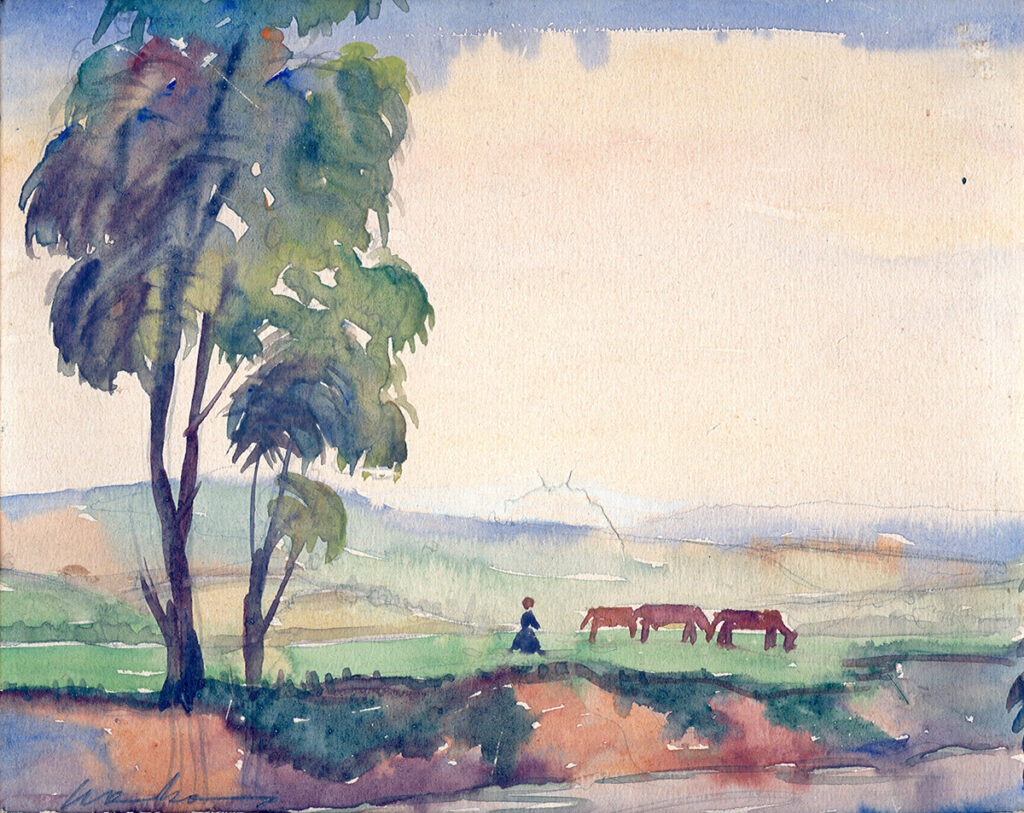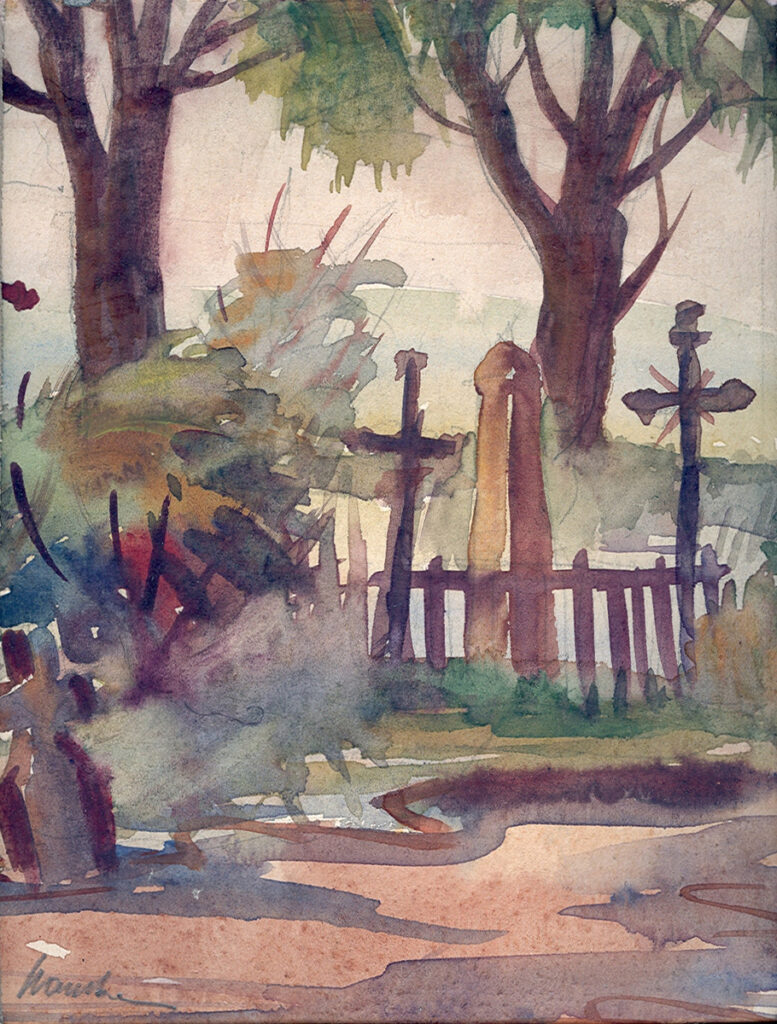

We are looking at the opposite river bank whose left side is covered in trees and there is a woman with three cows on the right. The image is very sketch-like, relaxed, the background melts into blurred colours, the small surface area of the painting captures the atmosphere very convincingly, without the need for any details to fill in the blanks. It is a simple genre landscape, but from a broader perspective of the artist’s program, it is a very unconventional work for him.
Ľudovít Slamka almost never focused on “rural” themes, like grazing cattle, his landscapes are usually dominated by urban motifs, and he also used the technique of aquarelle very rarely. The Nitra Gallery collection contains only one other aquarelle from this period, it features a similar atmosphere and colour palette, but not the subject – it depicts an old cemetery (O 1934 – Ľudovít Slamka: The Historical Cemetery by the Former Camaldolese Monastery on Zobor in Nitra, 1930 – 1939, aquarelle on paper, 18 x 14 cm).
The 1930s were marked by a global economic depression, the establishment of several autocratic regimes, unstable political landscapes both in Europe and worldwide, unemployment, emigration and social issues. These themes were also reflected in Slovak art. Ľudovít Slamka, a fresh graduate of the Academy of Fine Arts in Budapest, spent the whole decade focusing on various social and critical motifs. Among the most distinctive ones were his expressive and naturalistic portraits of people living on the fringes of society, like beggars, vagrants or workers. Unfortunately, many of his works from the 1930s are lost forever.1 However, the Nitra Gallery collection includes one of Slamka’s best paintings from this period, capturing in an expressive, or perhaps even grotesque way two old women praying the rosary at a cemetery gate. (O 262 – Ľudovít Slamka: At a Cemetery, 1936, oil on canvas, 87 x 71 cm)
World War II halted Slamka’s promising creative development and due to his financial troubles, he could no longer afford to keep working as a freelance artist and art later became only a hobby of his which did not respond to the period trends in painting. Nevertheless, his work becomes interesting again in the 1960s when he focused mostly on urban vistas – narrow streets, secluded places, historical monuments and Nitra’s subdivisions. He also produced a few “seaside” images inspired by his travels to Yugoslavia, Bulgaria and Italy. Ľudovít Slamka was a regional artist and his style did not offer anything progressive for that time, but the most important part of his program is the documentary aspect of his work as he was able to capture the undergoing development of Nitra. Nitra Gallery owns almost forty oil paintings from this period where he uses his characteristic short and energetic brush strokes, thick black outlines and colourful palettes, effectively capturing the daylight or the given season and recording the birth of new residential areas and various other public buildings, from the Slovak University of Agriculture to the Specialised Hospital on Zobor.
Ľudovít Slamka (August 25, 1906, Nitra – May 22, 1969, Nitra)
Between 1913 – 1921, he studied at the State Real Secondary Grammar School in Nitra. This is where he met with other important Nitra natives – Edmund Massányi, who also later became a fine artist, and Štefan Valent, the future founder of Nitra Gallery. All three of them attended the same after-school drawing class led by a professor of Czech origin, Oldřich Kalandra. Between 1921 – 1924, Slamka studied at the Business Academy in Prague and in 1924, he attended the Private Art School of Gustáv Mallý in Bratislava. Between 1925 – 1926, he studied at the Academy of Fine Arts in Prague under prof. Jakub Obrovský. Between 1926 – 1931, he attended the Academy of Fine Arts in Budapest where he studied under Emil László Baranszky (figural painting and composition) and Ferenc Olgyay (printmaking), but Slamka’s work, his painting style and incorporation of colours were mostly influenced by his stay at the studio led by prof. Július (Gyula) Rudnay. The Nitra Gallery collection includes about a hundred drawing studies from his academic years, mostly female nudes. It is interesting to note that he singed some of them as “Szlamka Lajos” or “Szlamka”, most probably due to his studies in Budapest. After his studies, he returned to Nitra and set up a studio in his parents’ house on Dolnotabánska Street, around the location of today’s department store formerly known as Prior. Before World War II, he was a member of the Slovak Art Forum and in 1938, he participated at an exhibition of Slovak art in New York. At the time, he was working on the already mentioned social and critical themes as well as portraits (also on-demand ones), landscapes and occasionally on vistas or other genre themes. The reality of World War II also caused a lack of commissions which resulted into his existential problems and he was forced to stop working as a freelance artist. In 1940, he started teaching at a vocational school in Nitra. From 1946, he taught technical and architectural drawing at a Secondary School of Civil Engineering in Nitra where he worked until he died abruptly after a brain aneurysm he suffered at home in his studio.
— Omar Mirza, August 2023
Notes
1 Medvecký, unpaginated.
Bibliography
HUČKOVÁ, Marta. Súpútnici, Edmund Massányi 1907-1966, Ľudovít Slamka 1906-1969: maliari nitrianskych vedút [Companions, Edmund Massányi 1907-1966, Ľudovít Slamka 1906-1969: Painters of Nitra Vistas]. Nitra: Nitra Gallery, 2006. ISBN 8085746301.
MEDVECKÝ, Ľudovít. Július Bártfay: sochy – Ľudovít Slamka: obrazy [Július Bártfay: Sculptures – Ľudovít Slamka: Paintings]. Nitra: Nitra Gallery in Nitra, October – November 1966. [exhibition catalogue]
VÁROSS, Marián. Slovenské výtvarné umenie 1918-1945 [Slovak Fine Art 1918-1945]. Bratislava: Slovenské vydavateľstvo krásnej literatúry, 1960.
Inventory No.: O 1961
Artist: Ľudovít Slamka
Title: On Pasture by the Nitra River
Year of origin: 1934
Technique: aquarelle
Material: paper
Dimensions: height 18,5 cm; width 23 cm
Signature: bottom left: Slamka